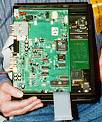

Towards the end of 1995, Viscorp applied and were granted a
licence by Escom to produce Amiga-based set-top systems. These
would have been based around existing Internet standards, turning
the Amiga into a internet-ready machine considerably cheaper than
the PC and Mac rivals. Viscorp had already been developing a
set-top box called UITI since 1990, the licensing of Amiga
technology allowed them to tap into an already existing market. If
the net computer idea failed it could always be sold to the Amiga
clan. The ED would turn into a full Amiga with the addition of a
keyboard and disk drive. There were also plans to create an ED card
for the Amiga to provide ED based facilities. Software that ran on
the Amiga, it is claimed, will run on Amiga, and vis-versa.
| Universal
Internet Television Interface (UITI) |
Developer: VIScorp
Developed: 1990 - 1996 |

The UITI was Viscorp's first Amiga network box, that had been in
development since 1990. By 1996 they were ready to test it in
American homes and had comissioned a study. The press release
indicated the machine provided full Internet access and web
capabilities, but did not go into specifics. There was also a
built-in speaker phone, caller ID, fax and e-mail capabilities plus
telephone functions. The UITI was originally slated for release
sometime during the fourth quarter of 1996 (Winter), but with
Viscorp's financial troubles at the time the project was never
released.
Developer: VIScorp
Developed: 1995 - 1996
Expected release: 4th quarter, 1996 |

This was VisCORP's second attempt at an Internet computer, or
Electronic Device (ED) as they called it. It is based on a more
advanced version of the UITI, promising multimedia features such as
telephone management, you can actually read who it is that is
calling you on the TV screen using the built-in database and answer
with the remote control, and internet access. A magnetic card
stripe reader would also be included for banking services, as well
as connection to a voice "bulletin board," support for multi-player
games across the internet in real time, e-mail and fax. The ED
would also use software similar to Java to run programs from a main
server on the computer. It is alleged to have included a 020
processor, 2mb chip ram and 4mb fast ram and a modular
communication port that allowed for faster modems, ISDN adapter,
Ethernet and cable modems, etc. The ED would have cost around 300
US dollars.
Viscorp subcontracted some of the development to other
companies, including ANQ who were responsible for developing
operating system modules, simulations of graphical user interfaces
and integrated applications including a children's painting
program. To see an image of some of the software created by ANQ for
the set-top box click here.
Distribution would have also been handled by third parties
through licensing the technology to a number of manufacturers and
distributors, including Pioneer, Zenith, Toshiba, and Freedom Star.
This would hopefully have made the ED a standard Internet system
with a large market share, rather than being forced to catch up
with internet standards.
| Processor |
68020 |
| Memory |
2Mb Chip RAM,
4Mb Fast RAM |
| I/O Ports |
Magnetic card stripe reader,
modular communication port |
| Price (USD) |
$300 |
Viscorp were one of the first companies to know of Escom's
troubles and arranged to buy Amiga Technologies from them. While
the transaction was being completed, Escom went into liquidation
slowing down the process. After a few months of legal discussions
Viscorp were forced to pull out of the bidding due to a lack of
finances. Without the hardware licence that they needed, the ED
could not be released and Viscorp chose not to pursue the deal
after Gateway bought the Amiga. After the failed acquisition the
company has moved to California and are trading under the name of
USDI.
BACK |













